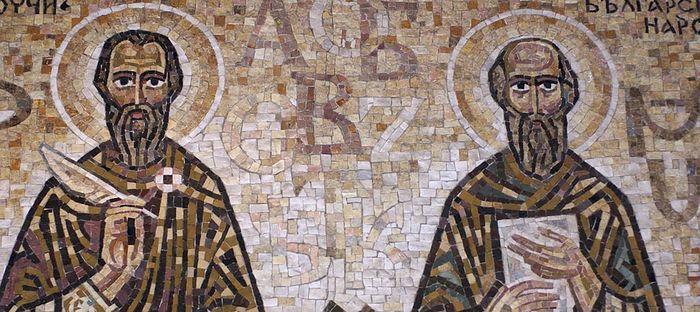This article was written in 2007, but we have translated it for today, the feast of Sts. Cyril and Methodius, as a fascinating account of this region where the saints labored, and which few of us know anything about.
History has never treated a capital city like this: wiping it off the face of the earth and turning its back on it. I am speaking of Mikulčice. But was this little town, now Czech and on the border of Slovakia, a capital? Josep Solz, the director of the largest museum in the world that preserves the memory of the mission of Sts. Cyril and Methodius, considers that it was. First Mikulčice,[1] and then Veligrad were, in his opinion, the capital cities of the nation of Great Moravia. Great Moravia, not for long—only 100 years until 906—existed in the very center of Europe, on the lands of modern Czech Republic and Slovakia, partially Austria, Hungary, and southern Poland. It was seized by Magyars.
Everything moved away from this place—two towns, history, and human memory. Fields, meadows, and woods separate Mikulčice, a Czech town, and Kopčany, a settlement consisting of three parallel streets, on the Slovakian side of the river.
 Mikulčice, the Morava River in the background. Visible are the foundations of ancient buildings.
Mikulčice, the Morava River in the background. Visible are the foundations of ancient buildings. Between Mikulčice and Kopčany flows the Morava River.
Four hundred meters from the Morava is that very place from which history turned away, gone to build other capital cities—Bratislava, Prague, Vienna, and Budapest, remarkably concentrated in one area.
So what was here, in these fields and meadows over the Morava?
“This was a capital city—the most important city in Great Moravia, which had existed for 1100 years already,” confirms Director Josep Stolz. “In 863, to this capital, Mikulčice, the ruler of the Great Moravian empire Prince Rostislav brought two missionaries from Byzantium—the Thessalonian brothers Cyril and Methodius.”
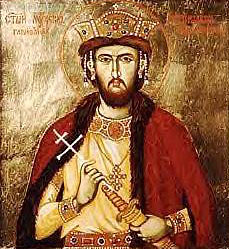 St. Rostislav, Prince of Great Moravia.
St. Rostislav, Prince of Great Moravia. He chose Constantinople, although right next to him was the flourishing Carolingian empire that had already converted to Christianity (with a German dynasty ruling until 911), which had the guarantee of safety from Rome, and Bavarian bishops were already missionizing it. His decision might seem strange. But Rostislav most likely feared receiving Christianity from the West because he knew that along with it he would fall into political dependency upon Germany. And he wanted an independently existing nation. Constantinople was far away, and there was no danger of dependence. Anyway it was not Constantinople’s mission to politically subject lands to itself. For example? A century later when Kievan Rus’ converted to Christianity it did not become part of Byzantium, although it neighbored the Eastern Roman Empire [Byzantium].
Besides, in the East, by the Bosporus, in Asia Minor, on the shores of the Aegean and Black Seas—culture, the sciences, and civilization were flourishing. The Byzantine Empire had entered the second period of its prime under the governance of the Macedonian dynasty, which had entered the political arena along with the mission of Sts. Cyril and Methodius and remained in it for around 200 years. Then Constantinople was what Paris was to the world in the eighteenth and early nineteen centuries. The West was at that time still trying to shake off the darkness of the middle ages. The Carolingian Empire imported all the contemporary ideas, fashions, and goods from Byzantium.
Thus, most likely Rostislav wanted to belong to a better world.
So he built his power in Mikulčice, relying upon the mission from the East, and this did not particularly please the Bavarian bishops and his competitor for the throne, his brother’s son Sviatopolk.
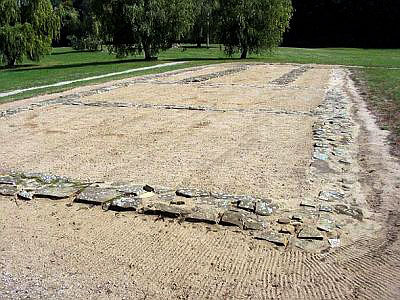 The foundation of a palace in Mikulčice
The foundation of a palace in Mikulčice We are walking upon soil that felt the steps of Rostislav, the holy brothers Cyril and Methodius, and their numerous disciples. Today, it is overgrown with grass and trees. Treasures are buried in the ground, and part of them is in the museum that was founded here in the 1950s. There is no other place in the world with such a large collection of monuments to the Cyril and Methodius mission, a few kilometers from modern Mikulčice, on the banks of the Morava River.
Director Solz leads us towards the Morava.
“This river (he describes a wide arc) did not flow where it does today, in an artificial bed; one of its many bends stretched around an island. On it towered a citadel. We have discovered the foundations of many of its structures. The most important of them is that basilica. You can clearly see the outline of its foundation. It was a whole thirty-seven meters long. Its aps faced east, just like the other eleven churches discovered in this place. How important must the city have been if out of the twenty-four Cyril and Methodius churches discovered in former Czechoslovakia, half of them are here! But not only do the foundations of churches testify to the city’s wealth. If in other excavation sites no more than six or seven swords have been found, here there are sixteen, and that is not to mention the many other valuable finds—buckles, fasteners, stirrups, tools, and boats.”
Probably the most important of these finds were the riltsa—pen nibs. They were used to write on tablets covered with wax. There were about 200 riltsa found. How common it must have been among the inhabitants to be able to read and write! This was characteristic—the missionaries from the East were enlighteners of very broad circles, while missionaries from the West did not spread the ability to read and write outside a small circle of clerics. They used the Latin, which was unintelligible to simple folk. Latin became the language, to use the language of anthropologists, of a specific clan—the male clan. It was not the language of children or women.
We introduce ourselves and say that we are from Poland, and here Director Joseph Solz, a man with experience in contact with various people, notes that we might not understand each otherT
“Orthodox”, we hasten to add. The director is no longer worried about misunderstandings. He tells us that he has very good relations with the Orthodox hierarch, Archbishop Christopher of Prague and the Czech lands.
Director Solz leads us to the place where the basilica’s aps once was.
“In the opinion of docent Klanitsa, here was the iconostasis,” he points out, “and here, to the left of the altar table, a grave was found. It was empty. Docent Klanitsa considers that in this place of great honor St. Methodius could have been buried. A gold button was found in the grave. It was not made by a local craftsman. It came from a Byzantine workshop.”
“Where is the body of St. Methodius?” I ask.
“Perhaps when the times of persecution against the disciples of the brothers Cyril and Methodius came, his body was hidden as a relic in one of the monasteries on the Danube. This is one of the scholars’ suppositions.
“From the time that I came here as the director, that is, for the last sixteen years,” our guide adds, “Vladyka has served here every year. Mostly Bulgarians come to the feast; last year twenty full buses came. The ambassadors of Bulgaria and Czech Republic are always in attendance. Last year even the president of Bulgaria and his wife came.”
May 24 is the festival of the Bulgarians’ written language, the most important festival of their culture. Bulgarians, probably more than any other Slavic nation, feel themselves to be the heirs of the mission of the saints from Thessalonica. To their lands fled the majority of the disciples of Cyril and Methodius from Great Moravia, amongst whom were Sts. Naum and Clement (of Ochrid). Around 200 disciples were forced to leave the Moravia that had become hostile to them after Methodius’s death (885).
By 871, unfavorable winds had begun to blow against them from the West. This is because in that year, Sviatopolk came to power supported by his German protectors. He blinded Rostislav and handed him over to the Franks. Methodius (Cyril was no longer among the living—he had died two years earlier in Rome), during his time as archbishop (875–885) spent two and a half years as a prisoner of the Bavarian bishops. He was freed thanks to the interventions of the bishop of Rome.
Director Solz went twenty times to Rome—the city where St. Cyril reposed, and each time on his own money. He was also several times in Kraków at Wawel.[2]
In the whole world there are only two known rotundas with two apses. One of them is in Mikulčice, and the other is in Kraków, under one of the Wawel chapels.
At the Mikulčice excavations was also found the foundation of a building without an aps. Our guide considers that judging by its size, this is a prince’s palace. All the objects extracted from this excavation site are more than 100 years older than those found during excavations in Prague’s old city. The Bavarian missionaries had already arrived in Prague by that time. Probably there the people and aristocracy showed less resistance to another Christianity, of the Latin type.
But the capital of the first Christian mission—of the Slavic type—must have been leveled to the ground. When? Already during Sviatopolk’s time. Over the centuries the earth hid it under itself and a green sheath of grass and bushes.
Everyone forgot that was once something here of particular historical significance for Central Europe, including for Poland.
But the place names survived: Kościelisko, Kláštorisko (indicating “church” and “cloister” respectively). They gave no peace to modern archeologists who came there in the mid twentieth century and began excavations. Thus was an unusual land filled with treasures revealed. After them came university scholars. Over this half-century they solved many puzzles. Now this museum and academic society is making efforts to enter the excavations in Mikulčice into the list of UNESCO monuments.
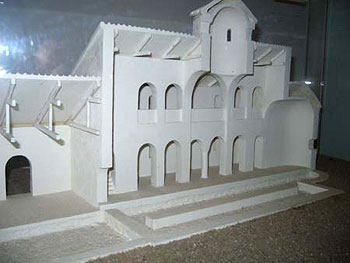 Mikulčice. Reconstruction of the ancient basilica.
Mikulčice. Reconstruction of the ancient basilica. On the stone is a citation from the words of a monk named Khrabr, about whom we know nothing. In my translation they would sound like this: “You ask the Slavic scholars who created your alphabet or who translated books for you? Here all know and all reply. Constantine, called Cyril, and his brother Methodius, both created writing, and translated books.
In 1990 a cross was erected next to the monument—a six-pointed one.
We make a broad arc; we cross the bridge over Moravia. We are in Slovakia. The nearest town is Halič. Further on is Kopčany. It is one and a half kilometers from Kopčany to the Mikulčice excavation site as the crow flies. We ask some women where the oldest church is. They all point to a Catholic church near the city square. We drive through endless cornfields divided by a road. Finally we see a red dot, and we head for it. Yes, this is the roof of the little church we are looking for. We recognize it from photos found on the internet. It stands amidst a sea of corn, right in the field. It has no fence. It is the oldest and only miraculously not destroyed testimony to Christianity on the north of the Danube. It looks like the unneeded guardian of a foreign, or rather their own renounced history.
The quiet of the autumn midday has made a swarm of flies lazy, and they are plastered all over the southern wall of the church. I frightened them. They were not used to such invasions. I walk around the edge of the building, measuring it with my steps. Eight around and five across (8.6 x 5.3 meters).
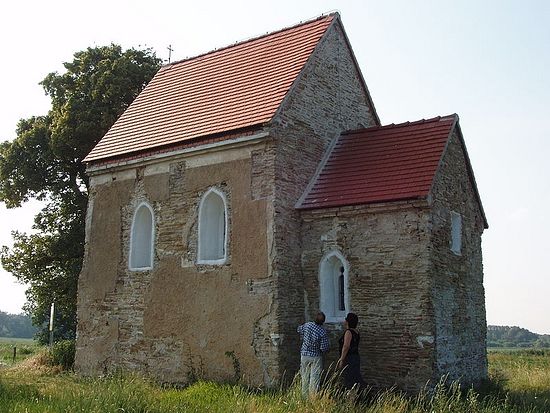 The Church of St. Margaret of Antioch in Kopcani.
The Church of St. Margaret of Antioch in Kopcani. From the internet printout I read that the valley on which the church stands was in the ninth (the time of the holy brothers’ Great Moravian mission) and tenth centuries densely populated. The Mojmir princes (of Great Moravia) lived here. Again a question arises: Why did the princes and people flee from here? Did someone kick them out? Did someone destroy their city? After all, it was in an excellent location—over the Morava River, and perhaps like Mikulčice was surrounded by one of its bends as by a moat?
Scholars dated the building to the ninth or tenth century. It is grouped with the “romanesque sites”.
The institute for the preservation of monuments in Bratislava from 1994–2000 thoroughly researched the church. The roof was changed. They left the Romanesque windows—glass as if sunk into the stone walls. No one asks for its restoration. Broad cracks in the old doors reveal the interior. A folding table, a plastic chair, an old umbrella, a shabby stepladder, a bucket and some garbage are the church’s only furnishings.
The church bears the name of St. Margaret of Antioch.
A young woman appears before the church—she rode here on a bicycle, with her child. She says that her prayers are heard here best of all.
Mikulčice, Nitra, Stare Mesto (Old Town), Uherské Hradiště—these are towns that grew during the princedom of Rostislav and the brothers’ mission. Churches and monasteries were built in them. Slavonic literacy thrived in them. They were located in the heart of Great Moravia, which stretched from the north of the Danube, through what is today the Czech Republic and Slovakia, near the border between them.
Why did lands that were over a thousand years ago the center of a sovereign state become the provinces? Only some catastrophe could have caused such a sudden turn in their histories. Could that turn have been the cruel extermination of Slavic Christianity in Great Moravia?
Anna Radziukovich
Translation from the Russian version by Nun Cornelia (Rees)
Originally written in Polish

